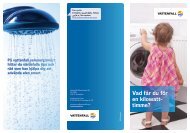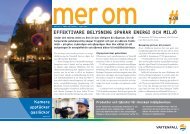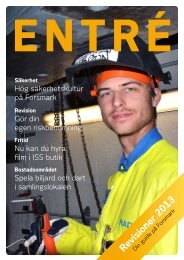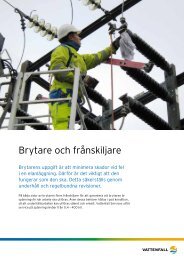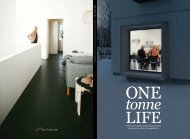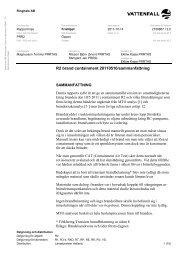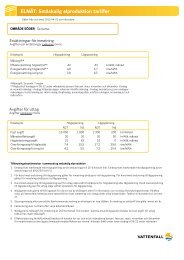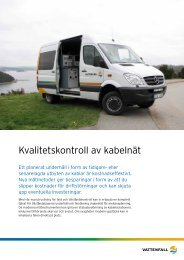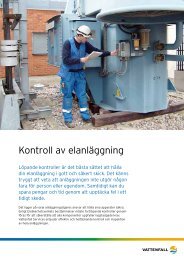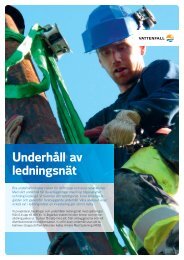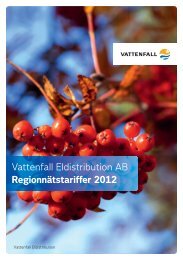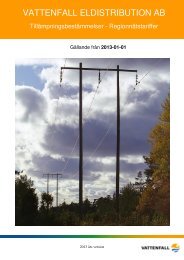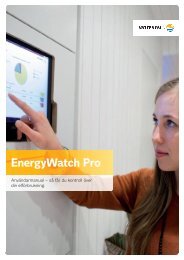This environmental impact assessment for Kriegers flak ... - Vattenfall
This environmental impact assessment for Kriegers flak ... - Vattenfall
This environmental impact assessment for Kriegers flak ... - Vattenfall
You also want an ePaper? Increase the reach of your titles
YUMPU automatically turns print PDFs into web optimized ePapers that Google loves.
16.3 The effects on the environment<br />
and the consequences thereof<br />
16.3.1 The Construction Phase<br />
16.3.1.1 The Sea<br />
Temporarily, the water will become cloudy and the<br />
sediments will be affected in connection with the<br />
laying of cables and construction of the trans<strong>for</strong>mer<br />
stations.<br />
As mentioned earlier, the cables will be placed<br />
under the seabed by washing, plowing or digging. In<br />
all cases, a temporary clouding of the water will occur.<br />
The extent of the spread of sediment is dependant on<br />
the nature of the bottom and currents.<br />
Were digging will occur (nearest to the coast) the<br />
shifted material will be put back and where plowing<br />
and washing will occur, the softened material will<br />
be put back in the cable shaft. A reasonable view is<br />
that within a year or two the seabed will return to its<br />
natural state.<br />
When the seabed material has been put back, the<br />
water will become clear again.<br />
During the construction of the trans<strong>for</strong>mer stations,<br />
physical <strong>impact</strong> will occur similar to that accounted <strong>for</strong><br />
in Chapters 5.7.1.1. and 5.7.1.2.<br />
As a relatively insigniÞ cant and temporary clouding<br />
of the water will occur, the <strong>impact</strong> on ß ora and fauna<br />
will be negligible.<br />
The stationary ß ora and fauna existing in the area<br />
where washing/digging will occur (or piling/drilling<br />
<strong>for</strong> the foundations of the trans<strong>for</strong>mer stations), will<br />
be damaged or suffer from severely changed living<br />
conditions. The algae will in this area be torn up and<br />
drift away. Benthic animals will be exposed and may<br />
possibly move to other habitats.<br />
Fish will look <strong>for</strong> food among the uncovered organisms.<br />
During the construction phase, increased trafÞ c<br />
will occur in the area where the cable is laid. <strong>This</strong> will<br />
affect both commercial shipping and Þ shing. As this<br />
disturbance is limited in time, the negative effects will<br />
be small.<br />
16.3.1.2 Land<br />
As the cable laying mainly will occur across cultivated<br />
land, only a temporary <strong>impact</strong> on the land use will oc-<br />
CABLE LAYING 167<br />
cur. Crops will be damaged and there will be a certain<br />
<strong>impact</strong> on the use of land during the work, especially<br />
during wet weather. Crossing drainage must be dug<br />
that will be damaged but repaired when the work has<br />
Þ nished and the area been restored.<br />
The cable laying has been planned so that protection<br />
worthy environments and objects will be avoided. The<br />
construction may hit upon unknown ancient remains,<br />
but this will be dealt with in accordance with the<br />
Swedish National Heritage Law. The <strong>impact</strong> on animals<br />
and humans is judged as negligible as the activity<br />
can be compared to conventional light entrepreneurial<br />
activities. Noise limits will be in accordance with the<br />
rules of the Swedish Environmental Protection agency.<br />
16.3.2 The Operating Phase<br />
16.3.2.1 The Sea<br />
The cables will cause a magnetic Þ eld with a strength<br />
of 3.5 µT at maximum use. As a comparison, it could<br />
be mentioned that a vacuum cleaner and an electric<br />
drill at a distance of 30 cm would generate a magnetic<br />
Þ eld corresponding to 20 µT and a TV set 5 µT. The<br />
magnetic Þ eld generated by the cable would decline<br />
rapidly with the distance and end at a distance of 20<br />
metres, see picture below. Left then will be the natural<br />
magnetic Þ eld of the earth measuring 50 µT.<br />
No electric Þ elds will occur as the cables will be<br />
screened.<br />
On the other hand, a secondary electric Þ eld will be<br />
generated. <strong>This</strong> Þ eld is, however, very faint and will be<br />
of no consequence.<br />
The cables generate heat and calculations have been<br />
made in order to Þ nd out whether the cables would<br />
generate any signiÞ cant heat. During these calculations,<br />
a worst scenario of maximum output and summer<br />
temperature of the water were used. The result<br />
showed no signiÞ cant increase in temperature of the<br />
seabed.<br />
16.3.2.2 Land<br />
After the construction area has been restored, the land<br />
can again be used as be<strong>for</strong>e. The cables will generate<br />
some heat but this will have no negative <strong>impact</strong> on<br />
the surroundings. Maintenance and supervision will<br />
in principle only take place during digging activities<br />
around the cables or when a fault has been reported.




